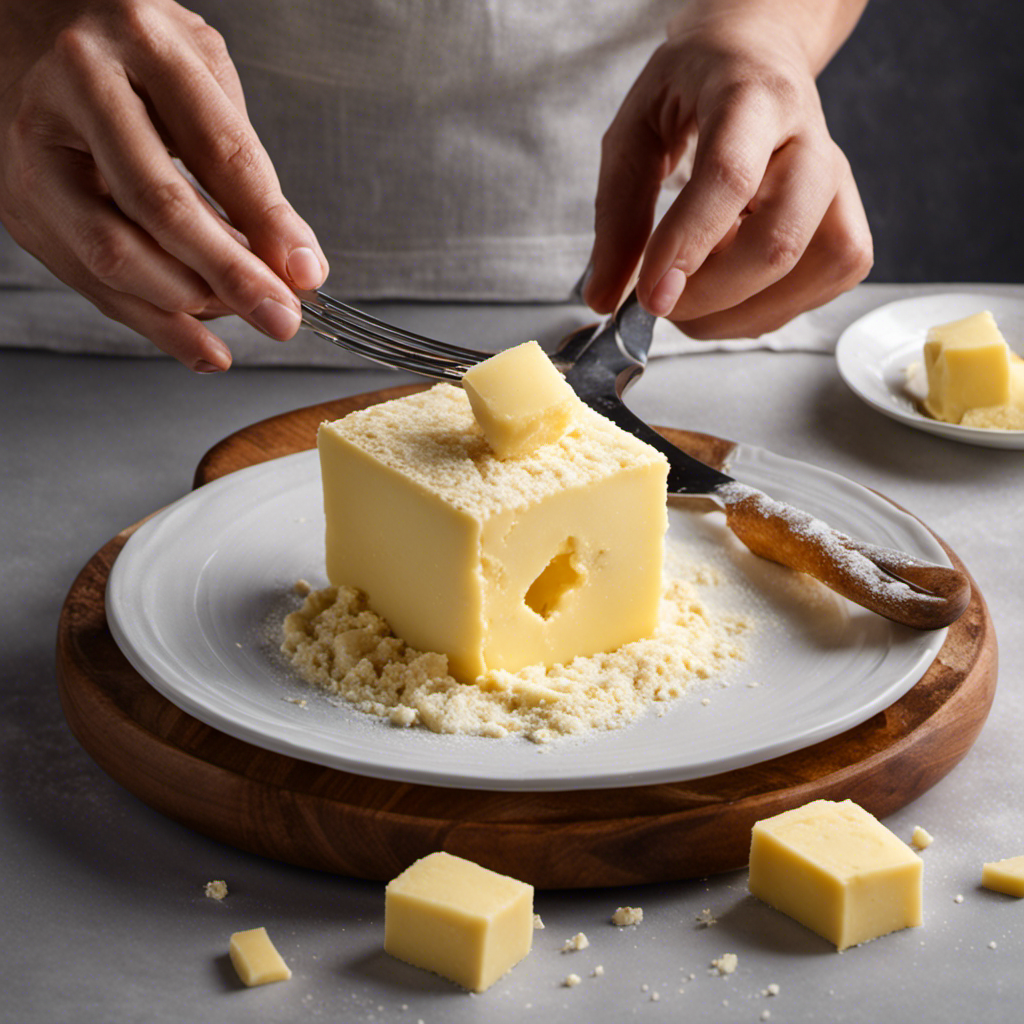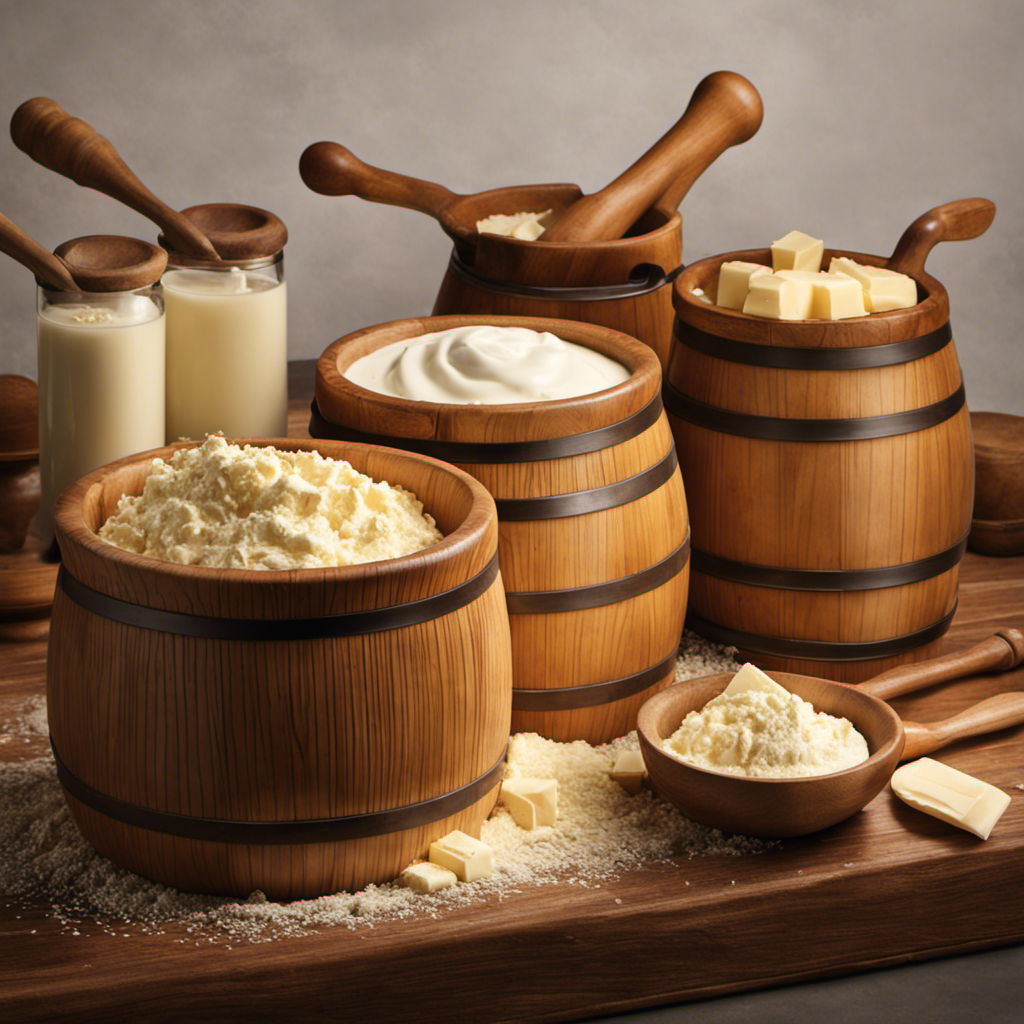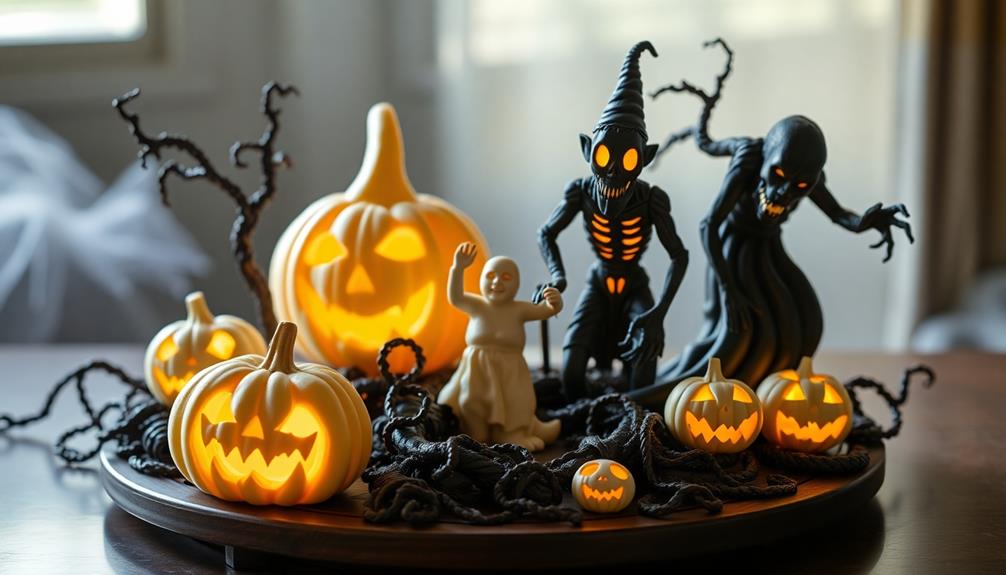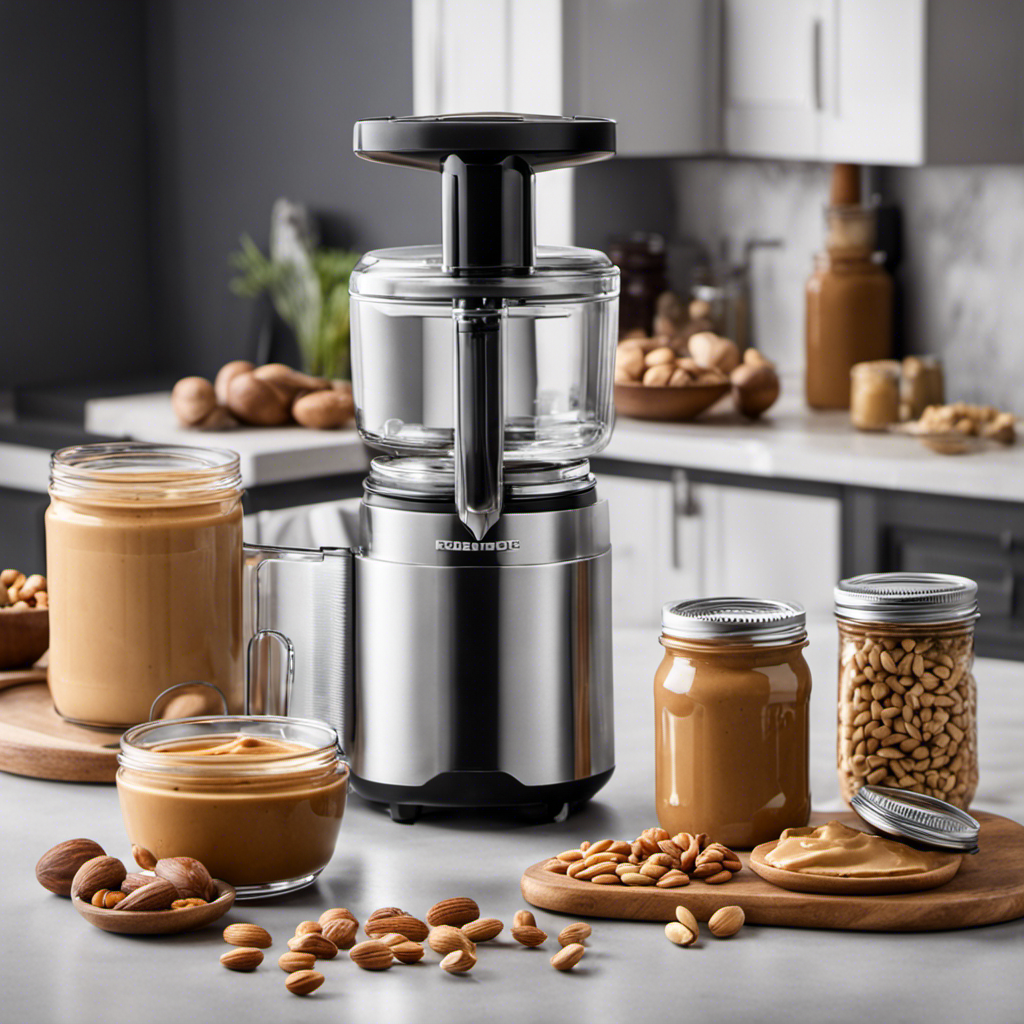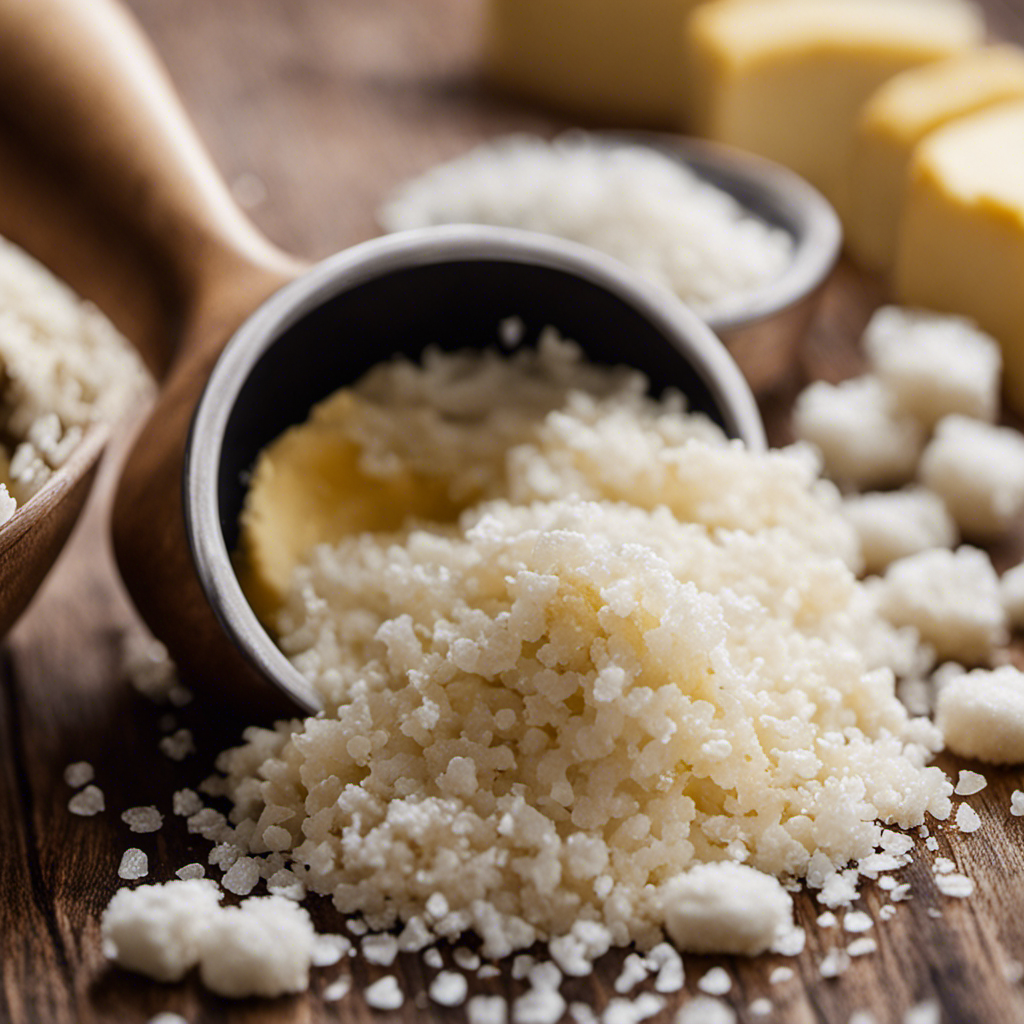I have always been curious about which attachment is the most effective for creaming butter and sugar. After thorough research and testing in my own kitchen, I am happy to share the results.
In this article, I will share my findings on the various attachments available for stand mixers and hand mixers, including the whisk, paddle, beater, blender, and food processor attachments.
Get ready to elevate your baking game and achieve the perfect creamy texture with the right attachment.
Key Takeaways
- The paddle attachment in a stand mixer is the best for creaming butter and sugar, while the whisk attachment in a hand mixer is also effective.
- Creaming butter and sugar at room temperature helps with easier mixing and achieving a light and fluffy texture.
- Stand mixers offer better control over mixing speed and consistent mixing for thorough creaming.
- The creaming technique is crucial for achieving the desired texture in baked goods, and the beater attachment is highly effective for creaming butter and sugar.
Stand Mixer Attachments
You can use a stand mixer attachment to easily and efficiently cream butter and sugar together. When it comes to choosing the best stand mixer attachment for this task, the paddle attachment is the most suitable. This attachment has a flat, paddle-shaped head that works well for creaming butter and sugar. It effectively combines the two ingredients, creating a light and fluffy mixture.
To achieve the best results using the creaming method, ensure that the butter is at room temperature. This allows for easier mixing and better incorporation of the sugar. Start by beating the butter alone until it becomes smooth and creamy. Then gradually add the sugar, beating until the mixture is light and fluffy. This process helps to incorporate air into the mixture, resulting in a lighter texture for your baked goods.
Using a stand mixer attachment with the creaming method can save you time and effort, giving you consistent and professional results every time.
Hand Mixer Attachments
When it comes to hand mixer attachments, finding the best one can make all the difference in your baking experience.
From wire beaters to dough hooks, each attachment serves a specific purpose and can greatly affect the outcome of your recipes.
Additionally, understanding the mixing time differences between various attachments is crucial in achieving the desired consistency and texture in your batter or dough.
Best Hand Mixer Attachment
The best hand mixer attachment for creaming butter and sugar is the whisk attachment. Whisking techniques, such as using a whisk attachment, are essential for achieving a light and fluffy texture when creaming butter and sugar.
The whisk attachment helps to incorporate air into the mixture, resulting in a smoother and creamier consistency. It is important to consider the creaming temperature as well. The butter should be at room temperature, around 68-70°F (20-21°C), to ensure proper creaming.
Using a whisk attachment at this temperature allows the butter and sugar to blend together more efficiently, creating a homogenous mixture. By understanding the importance of whisking techniques and creaming temperature, you can achieve the perfect creamed butter and sugar mixture for your recipes.
Now let’s explore the differences in mixing time.
Mixing Time Differences
To achieve the perfect texture, it’s important to understand the differences in mixing times.
When it comes to the effective creaming technique, using a stand mixer offers several benefits.
Firstly, a stand mixer provides consistent and even mixing, ensuring that the butter and sugar are thoroughly combined. This helps to create a light and fluffy texture in your baked goods.
Additionally, a stand mixer allows for better control over the mixing speed, allowing you to gradually incorporate air into the mixture. This air is essential for leavening and creating a tender crumb in your baked goods.
Lastly, using a stand mixer reduces the amount of manual labor required, saving you time and effort.
Whisk Attachment
Using the whisk attachment will help incorporate air into the butter and sugar mixture. This whisking technique is essential for achieving a light and fluffy texture in baked goods.
The whisk attachment, with its wire loops, creates small air pockets by rapidly beating the butter and sugar together. As the whisk spins, the loops push through the mixture, incorporating air and creating a lighter consistency. This method is particularly effective when making cakes, cookies, and other delicate desserts.
Alternative methods, such as using a paddle attachment or hand mixing, may not achieve the same level of aeration. The whisk attachment’s rapid spinning action ensures a thorough incorporation of air, resulting in a superior texture and rise in your baked goods.
Paddle Attachment
When it comes to the creaming method, using the paddle attachment is an effective option. It helps to create a smooth and fluffy texture by thoroughly incorporating the butter and sugar.
However, it’s important to note that there are other attachment options available, such as the whisk or beater attachments, which may yield different results.
The mixing time required with the paddle attachment will depend on the recipe, but generally, it should be mixed until the butter and sugar are light and creamy.
Effective Creaming Method
Creaming butter and sugar is essential for achieving a light and fluffy texture in baked goods. When it comes to the creaming method, there are two main techniques: creaming and beating. Creaming involves combining softened butter and sugar together until the mixture is light and creamy. This process incorporates air into the mixture, resulting in a tender and airy baked good. On the other hand, beating involves melting the butter and then beating it with the sugar. While this method can still produce a delicious treat, it often results in a denser texture. To illustrate the differences between creaming and beating, here is a table outlining their characteristics:
| Creaming Method | Beating Method | |
|---|---|---|
| Airiness | Light and fluffy | Denser |
| Texture | Tender | Dense |
| Ease | Requires softened butter | Requires melted butter |
Now that we understand the effectiveness of the creaming method, let’s explore other attachment options for achieving the perfect texture in baked goods.
Other Attachment Options
Let’s explore different ways to achieve the perfect texture in baked goods.
When it comes to creaming butter and sugar, most people rely on the traditional paddle attachment. However, there are alternative methods and attachments that can yield equally fantastic results.
One such option is using the whisk attachment. This attachment incorporates more air into the mixture, resulting in a lighter and fluffier texture.
Another alternative is the dough hook attachment, typically used for kneading bread dough. Surprisingly, this attachment can also be used for creaming butter and sugar. The dough hook gently combines the ingredients without incorporating too much air, resulting in a denser and more tender texture.
Mixing Time Required
To achieve the perfect texture in your baked goods, make sure you don’t overmix the ingredients. Overmixing can lead to tough and dense results.
When it comes to creaming butter and sugar without a mixer, it’s important to consider the impact of mixing time on the final baked goods. Here are some key points to keep in mind:
- Creaming butter and sugar by hand requires more time and effort compared to using a mixer.
- The longer you mix, the more air is incorporated into the mixture, resulting in a lighter texture.
- However, too much mixing can cause the butter to melt, affecting the overall structure.
- It’s crucial to pay attention to the consistency and appearance of the mixture, stopping when it reaches a light and fluffy state.
- The final texture of your baked goods will greatly depend on the mixing time, so be mindful and adjust accordingly.
Beater Attachment
The beater attachment mixes the butter and sugar together until creamy. This attachment is highly effective in achieving the desired texture for the creaming technique. The beater’s rotating action combines the butter and sugar, creating a smooth and fluffy mixture. It evenly distributes the sugar particles throughout the butter, incorporating air into the mixture. This aeration process helps to create a light and tender baked good.
To further illustrate the beater attachment’s effectiveness, let’s compare it to other attachments commonly used for creaming.
| Attachment | Effectiveness |
|---|---|
| Paddle attachment | Less effective |
| Whisk attachment | Less effective |
| Dough hook attachment | Not recommended for creaming |
As you can see from the table, the beater attachment outperforms other attachments when it comes to creaming butter and sugar. Its design and rotating action make it the ideal choice for achieving a creamy and light texture in your baked goods.
Blender Attachment
If you’re looking for a versatile attachment, try the blender attachment for a variety of blending and pureeing tasks. The blender attachment is a powerful tool that can handle a wide range of ingredients and tasks.
Here are some key features of the blender attachment:
-
Variable blender speed: The blender attachment comes with different speed settings, allowing you to control the blending process and achieve the desired texture.
-
High blender capacity: With a large capacity, the blender attachment can handle larger batches of ingredients, making it perfect for making smoothies or pureeing soups.
-
Sharp blender blades: The blender attachment is equipped with sharp blades that can easily blend through tough ingredients, ensuring a smooth and consistent blend.
-
Easy to clean: The blender attachment is designed for easy cleaning, with detachable parts that can be easily washed and dried.
-
Versatile use: Apart from blending and pureeing tasks, the blender attachment can also be used for making sauces, dressings, and even grinding nuts or coffee beans.
Overall, the blender attachment is a must-have for any kitchen, providing you with the convenience and efficiency you need for a variety of blending tasks.
Food Processor Attachment
With its multiple functions, the food processor attachment is a versatile tool for various food preparation tasks.
When it comes to creaming butter and sugar, the food processor offers several benefits. Firstly, it saves time and effort by quickly and efficiently combining the ingredients. The powerful motor and sharp blades ensure a smooth and creamy consistency.
Additionally, the food processor attachment allows for precise control over the creaming process, enabling you to achieve the desired texture for your recipe. Whether you’re making cookies, cakes, or frosting, the food processor attachment can handle the task with ease. Its ability to cream butter and sugar evenly ensures a consistent result every time.
Frequently Asked Questions
Can I Use a Blender Attachment to Cream Butter and Sugar?
Yes, you can use a blender attachment to cream butter and sugar, but it may not yield the best results. A stand mixer with a paddle attachment or a hand mixer would be better alternatives.
What Is the Difference Between a Hand Mixer Attachment and a Stand Mixer Attachment?
The difference between a hand mixer and a stand mixer attachment is that a hand mixer is portable and easier to store, while a stand mixer is more powerful and has more attachments available. Each has its pros and cons.
Can I Use a Beater Attachment Instead of a Paddle Attachment?
Using a beater attachment instead of a paddle attachment may affect the creaming process. The paddle attachment’s flat shape helps incorporate air into the butter and sugar, resulting in a lighter texture.
Is It Necessary to Use a Whisk Attachment for Creaming Butter and Sugar?
Yes, there is an alternative method to creaming butter and sugar without using a whisk attachment. The pros of using a paddle attachment are it’s faster and more efficient, but the cons are it may not incorporate as much air.
Can a Food Processor Attachment Be Used to Cream Butter and Sugar Effectively?
A food processor attachment or a blender attachment can be effectively used to cream butter and sugar. It provides a convenient alternative to using a whisk attachment, resulting in a smooth and well-mixed mixture.
Conclusion
In conclusion, after examining the various attachments available for creaming butter and sugar, it is clear that the paddle attachment is the most efficient and effective choice.
With its flat surface and flexible edges, it effortlessly combines the ingredients, resulting in a smooth and creamy texture.
Just like a conductor leading an orchestra, the paddle attachment harmonizes the butter and sugar, creating a symphony of flavor.
So, next time you’re in the kitchen, grab your paddle attachment and let it work its magic!

